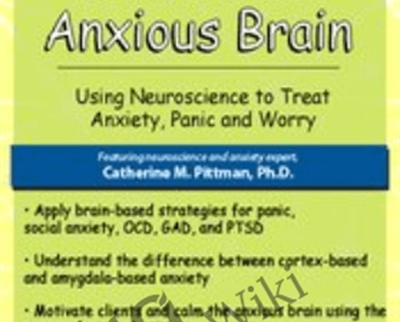Rewire the Anxious Brain: Using Neuroscience to End Anxiety, Panic and Worry – Catherine M. Pittman
Original price was: $199.99.$55.00Current price is: $55.00.
Rewire the Anxious Brain: Using Neuroscience to End Anxiety, Panic and Worry – Catherine M. Pittman Download. Therapy is about change – its about creating…
Salepage link: At HERE. Archive:
- Apply proven brain-based strategies for Panic, Social Anxiety, OCD, GAD, and PTSD
- Understand the difference between cortex-based and amygdala-based anxiety
- Motivate clients and calm the anxious brain using the power of neuroplasticity
- Increase client engagement by focusing on changing the brain – not simply decreasing anxiety
Join neuroscience and anxiety expert, Dr. Catherine Pittman, and learn her keys for successful anxiety treatment. Dr. Pittman integrates brain-based strategies for calming the anxious mind with client communication techniques that motivate change in your clients. Catherine’s approach promotes adherence to treatment and strengthens the therapeutic alliance – which is essential when working with anxious, worried, traumatized, or obsessive clients.
Dr. Pittman will give you proven tools and techniques to:
- Identify and treat the roots of anxiety in both the amygdala and the cortex
- Explain “the language of the amygdala” in an accessible, straight forward way
- Identify how the cortex contributes to anxiety, and empower clients with strategies to resist anxiety-igniting cognitions
Therapy is about change – it’s about creating a new self – and incorporating the concept of “rewiring the brain” is a potent method for stopping anxiety in its tracks.
- Ascertain the underlying neurological processes that impact anxious symptoms for clients.
- Develop client engagement in treatment using personalized goals and attending to the therapeutic relationship.
- Evaluate the differences between amygdala-based and cortex-based anxiety symptoms and identify how these symptoms inform treatment interventions.
- Communicate strategies for calming and training the amygdala in order to alleviate symptoms of anxiety.
- Implement methods for teaching clients to retrain the cortex so that anxiety is resisted rather than exacerbated.
- Analyze how psychotropic medication impacts neuroplasticity in the brain; identify related treatment implications.
Use Neuroscience in the Treatment of Anxiety
- Positives: We know more about anxiety-based disorders than any other disorders
- Science gives explanations, evidence, authority, destigmatizes difficulties
- Concerns: It can be difficult to explain, answer questions
- Clients may feel a lack of responsibility
- Oversimplification is inevitable
Enhancing Engagement in Treatment
- Don’t neglect the therapeutic relationship!
- Address the challenges of anxious clients
- Remember that strategies are effortful
- Guide the process using client’s goals
- Maintain motivation
Neuroplasticity
- Define Neuroplasticity in everyday language
- Therapy is about creating a new self
- “Rewiring” as an accessible concept for change
- Re-consolidation: the modification of emotional memories
Identify Two Neural Pathways to Anxiety
- Amygdala – bottom-up triggering of emotion, physicality of anxiety
- Cortex – top-down emotion generation based in cognition
- Explain the two pathways to clients
- How anxiety is initiated in each pathway and how pathways influence each other
Client-Friendly Explanations
- Use illustrations to create concrete understanding
- Fight/flight/freeze responses
- The “language of the amygdala”
- Anxiety and the cortex
- Help clients recognize the two pathways to anxiety
Neuroplasticity in the Amygdala (Essential for all Anxiety Disorders, PTSD, OCD, Depression)
- Sleep and the amydgala
- The influence of exercise
- Breathing techniques to reduce activation
- Relaxation, meditation, and yoga to modify responses
- Exposure as opportunities for the amygdala to learn
- Combating avoidance
- When anxiety indicates that the amygdala can learn new responses
- Push through anxiety to change the amygdala
Neuroplasticity in the Cortex (Essential for GAD, SAD, OCD, PTSD, Depression)
- “Survival of the busiest” principle—strengthen or weaken specific circuitry
- The healthy (adaptive) use of worry in the cortex
- “You can’t erase: You must replace.”
- Recognize and modify the impact of uncertainty
- Training correct uses of distraction
- Left hemisphere techniques- cognitive defusion, coping thoughts, fighting anticipation
- Right hemisphere techniques – imagery, music
- Mindfulness and anxiety resistances
Neuroplasticity and Medications for Anxiety Disorders, OCD, PTSD, Depression
- Medication’s effects in the rewiring process
- The myth of the chemical imbalance
- The danger of sedating the brain with benzodiazepines
- Promoting neuroplasticity with SSRIs, SNRIs
- The effectiveness of CBT and meds
Moving Beyond Diagnostic Categories to Focus on Anxiety Pathways
- Anxiety is a component of many diagnoses (depression, substance abuse, etc.)
- Amygdala- and cortex-based techniques help in other disorders
- Targeting brain-based symptoms rather than disorders
- Worry, obsessions, rumination respond to similar cortex-based techniques
- Panic, phobic responses, and compulsions respond to amygdala-based techniques
Here's an overview of the prominent keywords and a list of famous authors:
Business and Sales: Explore business strategies, sales skills, entrepreneurship, and brand-building from authors like Joe Wicks, Jillian Michaels, and Tony Horton.
Sports and Fitness: Enhance athleticism, improve health and fitness with guidance from experts like Shaun T, Kayla Itsines, and Yoga with Adriene.
Personal Development: Develop communication skills, time management, creative thinking, and enhance self-awareness from authors like Gretchen Rubin, Simon Sinek, and Marie Kondo.
Technology and Coding: Learn about artificial intelligence, data analytics, programming, and blockchain technology from thought leaders like Neil deGrasse Tyson, Amy Cuddy, and Malcolm Gladwell.
Lifestyle and Wellness: Discover courses on holistic health, yoga, and healthy living from authors like Elizabeth Gilbert, Bill Nye, and Tracy Anderson.
Art and Creativity: Explore the world of art, creativity, and painting with guidance from renowned artists like Bob Ross and others.
All the courses on WSOlib are led by top authors and experts in their respective fields. Rest assured that the knowledge and skills you acquire are reliable and highly applicable.
Specification: Rewire the Anxious Brain: Using Neuroscience to End Anxiety, Panic and Worry – Catherine M. Pittman
|
User Reviews
Only logged in customers who have purchased this product may leave a review.

Original price was: $199.99.$55.00Current price is: $55.00.












There are no reviews yet.